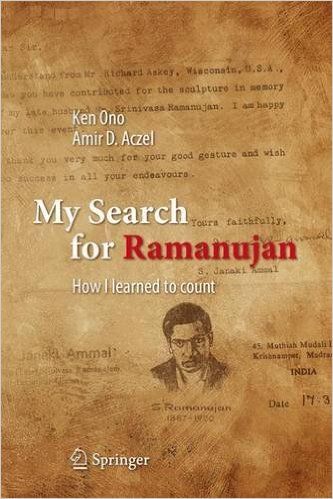Book Review: My Search for Ramanujan

Ken Ono and Amir D. Aczel’s book ‘My Search for Ramanujan: How I learned to Count’ is a memoir of Ken Ono’s mathematical journey. It is not an autobiography in the conventional sense, it is like a much needed desire to write about one’s life fulfilled. Ken Ono is one of the most widely acclaimed experts on the work of Ramanujan and when someone like him decides to write something about Ramanujan, one should listen. The book is divided roughly into three segments, the first is about Ono’s early childhood; the next is about how he discovered Ramanujan and a brief detour on the life of Ramanujan; and finally the part where Ono becomes a professional mathematician, doing mathematics very often guided by the work of Ramanujan.
Ono belongs to the post-war generation of Japanese immigrants in the United States, where his father Takashi Ono is also a brilliant number theorist. The struggles of living in a time when the memories of war were fresh is evident in the way Ono recounts several of his childhood memories. There are many things which makes one feel sad for the young Ono, but as the story progresses it may seem that all of those incidents were in fact urging him towards his true calling – mathematics. Ono was a star kid at school, but he decided to drop out of high school because of parental expectations and possibly a loss of self-confidence. While doing so, he argues that his parents might have been inspired by the example of Ramanujan, who himself was a college failure.
The first memory of Ramanujan for Ono was when his father received a letter from Ramanujan’s widow, Janaki thanking him for contributing towards making a bust of Ramanujan. This event turned out to be of singular importance in Ono’s life as he embarked on his scholarly journey. The guiding light of Ramanujan is clearly visible in his words and works. The book contains a small section on Ramanujan, which is by no means complete. The reader is advised to supplement this part with other writings on Ramanujan, most notably his biography by Robert Kanigal which is mentioned frequently in this book.
After initial hiccups, Ono manages to get a decent mathematics degree and continues to graduate school. In graduate school, he meets his supervisor Basil Gordon, another famous number theorist who nurtures him and encourages him to find his mathematical calling. The authors describe the journey of Ono since his graduate days in some detail, however with much of the mathematical work of Ono wrapped in only either fancy jargon or in a way that is not satisfying to a mathematical reader. This part of the book is interesting to read as we realize how even mathematicians of Ono’s stature may fear failure in the early stages of their life. This could be a huge morale booster for young students to read about someone who is at the frontier of mathematical research and having doubts about his position in the framework of research mathematics.
Toward the end of the book, we get to know more about Ono’s work which was inspired by Ramanujan, the book ends with a description of Ono’s first trip to India to pay his respects to Ramanujan at Kumbakonam. The epilogue is about this journey and is a captivating read, describing in some details where Ramanujan worked in India and so forth. The afterword is about some of the mathematics that Ramanujan did, the selection of which is excellent for a laymen, however for a mathematician who knows something about Ramanujan’s work might be disappointing because of a certain lack of detail. This facet of the book is worth questioning, how much mathematics must one put in a book of this type? There is perhaps no correct answer, however this reviewer would have loved a little bit of more details.
The book is well written, but lacks good copy editing. There are several misprints or grammatical errors which catches the eye. A lack of bibliography and index is telling for a book of this type. The authors mention several works of mathematics, with no references anywhere. A bibliography with exact titles of the mathematical works mentioned would have been a good thing for the young students who are likely to read this book and be inspired by the example of Ono. Another thing which caught this reviewer’s attention was that, for someone who knows a little bit of the work of Ono, it is easily noticeable that a sizable portion of his work is never mentioned. This could be because Ono is a prolific mathematician and has worked on things not exactly related with Ramanujan’s work. A side remark here and there about his other mathematical work would have given the readers a much more wider perspective of Ono’s mathematical breath and depth.
The book has certainly inspired the reviewer with the example of Ono, it makes for a nice leisurely read and one is given vivid images of the life of a mathematician, sometimes struggling and at times joyous of making a discovery. The book should be read, not to know more about Ramanujan but to know how a man from South India born almost a century ago is still inspiring people half-way across the world to search for meaning in their life of mathematics. The book would be a wonderful addition to someone who admires Ramanujan and is inspired by his example. It is really hard not to feel emotional about the subjects of the book – both Ramanujan and Ken Ono.
Title: My Search for Ramanujan: How I learned to Count
Authors: Ken Ono, Amir D. Aczel
Pages: 238
Publisher: Springer Switzerland
Price: Rs. 1,688
